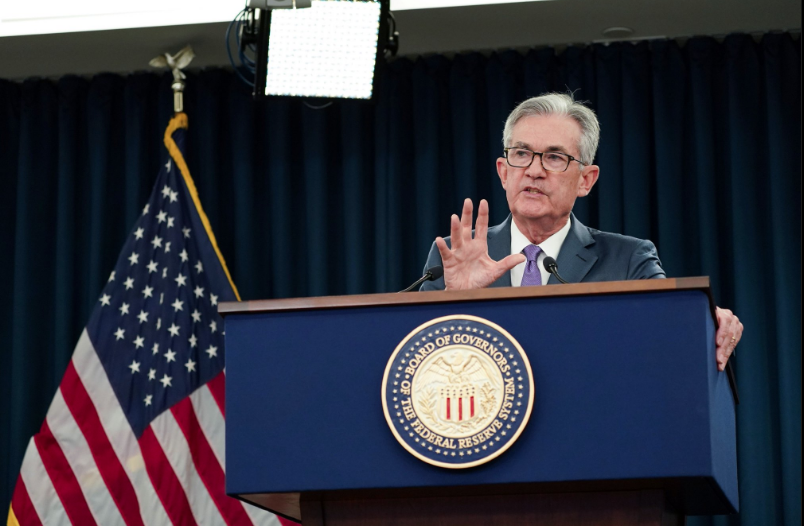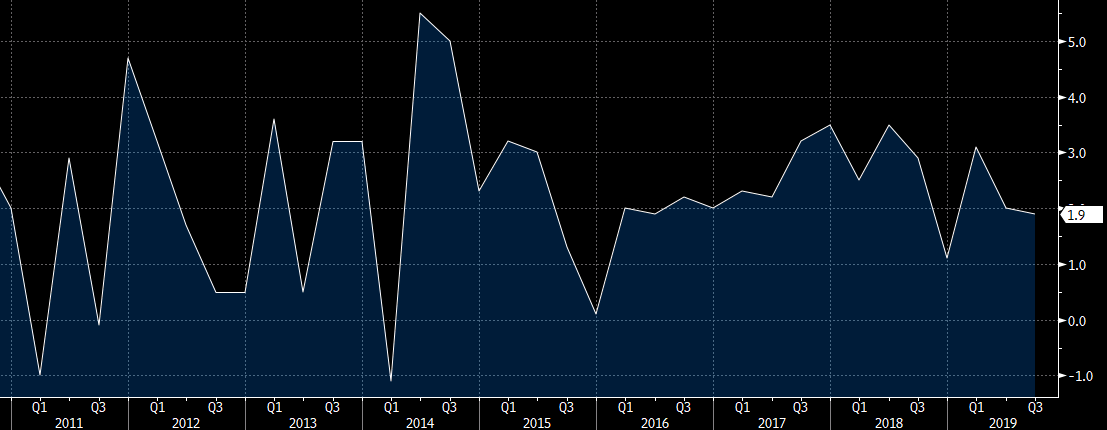Archives of “October 30, 2019” day
rssThe FOMC statement for the October 2019 meeting
FOMC statement for the October 2019 meeting…
October 30, 2019
Federal Reserve issues FOMC statement
For release at 2:00 p.m. EDT
Information received since the Federal Open Market Committee met in September indicates that the labor market remains strong and that economic activity has been rising at a moderate rate. Job gains have been solid, on average, in recent months, and the unemployment rate has remained low. Although household spending has been rising at a strong pace, business fixed investment and exports remain weak. On a 12-month basis, overall inflation and inflation for items other than food and energy are running below 2 percent. Market-based measures of inflation compensation remain low; survey-based measures of longer-term inflation expectations are little changed.
Consistent with its statutory mandate, the Committee seeks to foster maximum employment and price stability. In light of the implications of global developments for the economic outlook as well as muted inflation pressures, the Committee decided to lower the target range for the federal funds rate to 1-1/2 to 1-3/4 percent. This action supports the Committee’s view that sustained expansion of economic activity, strong labor market conditions, and inflation near the Committee’s symmetric 2 percent objective are the most likely outcomes, but uncertainties about this outlook remain. The Committee will continue to monitor the implications of incoming information for the economic outlook as it assesses the appropriate path of the target range for the federal funds rate.
In determining the timing and size of future adjustments to the target range for the federal funds rate, the Committee will assess realized and expected economic conditions relative to its maximum employment objective and its symmetric 2 percent inflation objective. This assessment will take into account a wide range of information, including measures of labor market conditions, indicators of inflation pressures and inflation expectations, and readings on financial and international developments.
Voting for the monetary policy action were Jerome H. Powell, Chair; John C. Williams, Vice Chair; Michelle W. Bowman; Lael Brainard; James Bullard; Richard H. Clarida; Charles L. Evans; and Randal K. Quarles. Voting against this action were: Esther L. George and Eric S. Rosengren, who preferred at this meeting to maintain the target range at 1-3/4 percent to 2 percent.
Federal Reserve lowers interest rates by 25 basis points, as expected
Highlights of the Federal Reserve interest rate decision on October 30, 2019:
- Rates lowered to range of 1.50%-2.00%
- Markets priced in a 97% chance of a cut before the decision
- Prior range was 1.75%-2.00%
- George and Rosengren wanted no change, they were the only dissenters
- Uncertainties remain, will assess appropriate rate path
- Change of wording in the statement says it will monitor incoming info “as it assesses the appropriate path” for the target range
- Sets IOER at 1.55%, as expected
- Economic activity has been rising at a moderate rate, the same as prior
- Repeats that job gains have been solid, on average, in recent months, and the unemployment rate has remained low
- Household spending has been rising at a strong pace vs ‘appears to have picked up’
- indicators of business fixed investment remains weak vs ‘business fixed investment has been soft’ prior
- Repeats that core and headline inflation running below 2%
- Says that market-based measures of inflation remain low vs ‘have declined’
- Says ‘uncertainties about this outlook remain’ vs ‘uncertainties about the outlook have increased’
Key line:
The Committee will continue to monitor the implications of incoming information for the economic outlook as it assesses the appropriate path of the target range for the federal funds rate.
vs prior:
the Committee will closely monitor the implications of incoming information for the economic outlook and will act as appropriate to sustain the expansion, with a strong labor market and inflation near its symmetric 2 percent objective.
It all comes down to how you read this change. Clearly, the Fed wanted to change it so they didn’t risk it being interpreted that another cut was coming. But they also didn’t want to take a cut off the table if it’s needed.
The market is reading that as hawkish. That’s probably the right call. There is about a 27% chance of a Dec cut priced in and that will have to go to zero unless there is a surprise in the economic data or trade policy. However the moves have been small.
The economic assessments were virtually unchanged.
Elon Musk says Tesla would have gone bankrupt if he didn’t shift production from solar
That’s quite the admission
Tesla would have gone bankrupt if CEO Elon Musk didn’t shift workers from Solar City to Model 3 production, he said in a deposition that was just made public.
“If I did not take everyone off of solar and focus them on the Model 3 program to the detriment of solar, then Tesla would have gone bankrupt,” Musk said in a June pre-trial deposition made public in state court in Delaware. “So I took everyone from solar, and said: ‘instead of working on solar, you need to work on the Model 3 program.’ And as a result, solar suffered, as you
would expect.”
That’s a pretty serious thing to admit — and not to disclose at the time it was happening.
The deposition was in a lawsuit from pension funds that argue Tesla shouldn’t have spent $2 billion to buy SolarCity when it was struggling itself. The insinuation is that Tesla bailed out Musk’s other project to save face.
China has offered for Trump to meet Xi in Macau as alternative to Chile
Fox News report
Edward Lawrence from Fox News reports that China has offered that the Trump travel to Macau to sign the Phase One trade deal, rather than the planned meet-up in Santiago, Chile.
Earlier today, Chile cancelled the APEC summit planned for November because of huge protests that have hit the country related to the high cost of living.
Markets wobbled on the initial announcement of the cancellation of the APEC summit but I don’t see it as any true obstacle to a Phase One deal. It’s a logistical problem but no reason to walk away from an agreement that — by all accounts — is very close to completion.
European equity close: Spain slumps in otherwise sluggish day
Closing changes for the main European bourses:
- UK FTSE 100 +0.4%
- French CAC +0.3%
- German DAX -0.2%
- Spain IBEX -1.5%
- Italy MIB -0.2%
The drop in Spain was the largest since October 2 and it was basically a product of Banco Santander falling 6.5% after it warned about capital levels coming under pressure from regulation.
The Fed decision today is all about the communication risks
The Fed probably wants to keep the market exactly where it is

The market has priced in a near-certainty of a cut today along with a 71% chance they will hold pat at the next meeting on Dec 11.
That pricing is probably where Powell would like to see the market finish the day. In an ideal world, they could cut today and not change guidance at all, leaving everything as it is.
However the statement itself is long and there are a multitude of communication risks. Then Powell will have to navigate a press conference.
Christopher Harvey, head of equity strategy at Wells Fargo Securities argues that Powell is due for a communication mishap.
“The last few times we heard him speak we got the distinct sense that the message he intends to convey is not always received as such by the markets,” Harvey wrote in a client note. “When it comes to commentary, we believe that less is more,” Harvey said. “Obviously, requiring a press conference for every Fed meeting suggests the Chairman holds a much different view. We shall see.”
For me, the biggest risk is that the FOMC wants to push back against the idea of a continued easing cycle. But by doing that, they risk sending a hawkish message that sparks a risk-off trade.
The dollar moves higher after better GDP data
GDP comes in at 1.9% for the 3Q in the advanced report
The dollar has moved higher after the better than expected US GDP for the 3Q. The growth came in at 1.9% annualized. The NY Fed GDPNow estimate was spot on this quarter at 1.9%. The Atlanta Fed model estimated growth at 1.7%. The Bloomberg GDP estimates of economists came in at 1.6%.
- The EURUSD has moved to a new session low and approaches the 100 hour moving average at 1.10999 (call it 1.1100). A move below would be more bearish.
- The USDJPY is out of its 9 pip trading range for the day (yes 9 pip). The price moved from 108.81 to a high of 108.938. Its 200 day moving average comes in at 109.027 today. Yesterday, the price moved above that moving average line but only briefly before backing off. A move above is needed to increase the bullish bias for the pair.
- The USDCHF has moved up to test its 100 hour moving average at 0.99372. A move above would be more bullish for that pair.
- The USDCAD has cracked back above its 200 hour moving average 1.3085 and trades near its high for the day at 1.3095. The high price from yesterday reached 1.3100 and backed off. The Bank of Canada is expected to keep rates unchanged at 10 AM ET.
- The AUDUSD has moved lower and trades at 0.6855 (the high for the day was up near 0.6875. The pair is approaching its 100 day moving average at 0.6847. The 200 hour moving average is not far away at 0.6846. Below that the pair’s 100 hour moving average comes in at 0.68371.
- The highs in the NZDUSD tested it’s falling 100 hour moving average (currently at 0.63588). The data sent the pair lower and away from the at MA line and is testing the days lows at 0.6344. The low from yesterday reached 0.6338 and the low for the week reached 0.6333.
Overall the dollar is higher against all the major currency pairs. US stocks initial reaction was a modest rise. The Dow is up about 30 points. The Nasdaq is up about 15 points.
US yields have moved a little higher, but just barely higher.
US Q3 advance GDP +1.9% vs +1.6% q/q annualized expected
The first look at third quarter 2019 US GDP:

- The final Q2 reading was +2.0%
- Personal consumption +2.9% vs +2.6% expected
- Prior consumption 4.6%
- GDP price index 1.7% vs 1.9% exp
- Core PCE q/q +2.2%
- GDP deflator 1.6% vs 1.9% exp
The inflation side of this report was significantly softer than anticipated and that’s the reason for the bulk of the upside beat.
Percentage contributions:
- Personal consumption added 1.93 pp
- Gross private investment -0.27 pp
- Inventories -0.05 pp
- Net exports -0.08 pp
- Government consumption +0.35 pp
The consumer is solid and inventories didn’t skew anything but the numbers are a bit softer than they look. It’s rare that net exports aren’t a drag and the trade deficit isn’t going away any time soon. At some point, governments will have to pull back on spending too.
Mnuchin: US economy continues to be strong
Comments by US Treasury secretary, Steven Mnuchin, in Riyadh
- US economy is strong, with low unemployment and low inflation
- But there is no question that global growth is slowing down
- China needs to do more on the fiscal side and regulation to maintain growth
A strong economy with strong rate cuts. Makes sense. As much as the Fed is trying to get ahead of the curve, it’ll be their own downfall if they have not enough spare capacity to cut rates further in the event of a major downturn.
